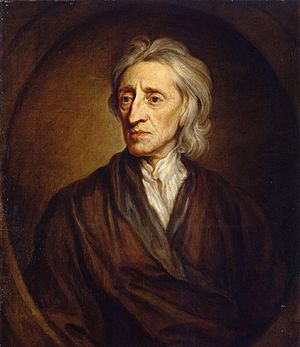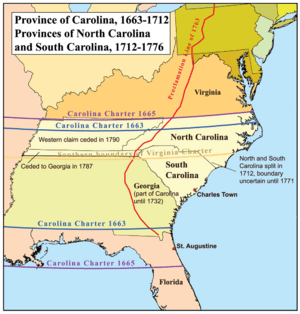Grand Model for the Province of Carolina facts for kids
The Grand Model was a big plan for how the Province of Carolina would be set up and run. This colony was started in 1670. The plan included a set of rules called the Fundamental Constitutions of Carolina. It also had detailed instructions for building towns and developing the land.
This whole plan was put together by an English thinker named John Locke. He worked for the Lords Proprietors of Carolina. These were eight noblemen who were given the right by the king to start the colony. Locke was also a helper to Anthony Ashley Cooper, who was one of the main Lords Proprietors. Ashley Cooper is seen as the founder of Carolina. Because of this, the Grand Model is sometimes called the Ashley Cooper Plan. Today, in Charleston, South Carolina, the term "Grand Model" often refers only to the original plan for that city.
Contents
What Was the Grand Model's Goal?
Anthony Ashley Cooper guided John Locke in writing the Fundamental Constitutions of Carolina. This happened after England had tried a different type of government that didn't work out. Ashley Cooper had learned a lot about laws and how governments should work. He believed it was important for Carolina to have clear rules from the start.
Ashley Cooper helped bring King Charles II back to the throne in 1660. In return, the king gave Ashley Cooper and the other Lords Proprietors the land for Carolina. Ashley Cooper strongly believed in England's old system of government. This system had a balance of power, where important families played a key role. The Fundamental Constitutions were designed to create a similar balanced government in Carolina. Even though some people called it a bit like the old feudalism system, it also included basic rights for people. It was a system based on different social classes.
How Towns and Land Were Planned
The Fundamental Constitutions gave a general idea for how towns and regions would grow. Once people started settling in 1670, more detailed instructions were sent to the colonists. These instructions filled in the gaps that the main rules didn't cover.
The way towns were designed in Carolina was influenced by the big plans made for London. This happened after the Great Fire of 1666 destroyed much of the city. The king asked for new ideas to rebuild London. Famous people like architect Christopher Wren and scientist Robert Hooke offered their designs. Their ideas helped make cities healthier, safer, and more beautiful. These ideas then influenced how Carolina's towns were planned.
John Locke's Role in the Plan

John Locke started working with Anthony Ashley Cooper in 1666. Soon after, he became a secretary for the Lords Proprietors. He then began writing the Fundamental Constitutions of Carolina and other planning documents. We don't know exactly how much Locke shaped every detail. But he was certainly guided by Ashley Cooper's overall vision.
You could say Locke was the "chief planner" for Carolina. He wrote rules for how towns should be built. He even drew an example plan to send to the colonists. His town plan included specific rules for things like the size of city blocks, how big building lots should be, and how wide streets needed to be. These rules were similar to modern city planning and zoning laws.
Locke also wrote guiding ideas for how the whole region should develop. These ideas were very much like modern planning ideas, including parts of sustainable development and smart growth. For example, he wanted:
- Consistency: All building should follow the main plan (the Fundamental Constitutions).
- Concurrent: Roads and other services should be built at the same time as new areas are developed.
- Compactness: Development should be close together to use land well and make it easy to get to markets.
Slavery and the Grand Model
John Locke famously spoke out against slavery in his book Two Treatises of Government. He wrote about the idea that all people are naturally equal. However, the Grand Model did allow for slavery. Because of this, some experts have called Locke a hypocrite. This is because he helped design Carolina, which included slavery, even after writing against it.
The Fundamental Constitutions did have a rule allowing slavery. But Locke's detailed planning documents, which he controlled more directly, don't mention slavery. So, while Locke and Ashley Cooper expected Carolina to have enslaved people, like most other colonies, they probably didn't expect it to become a colony that depended entirely on slavery.
It's also true that Locke had some financial ties to slavery. He was one of the first investors in the Royal African Company. This company was given a special permission by King Charles II in 1672. Between 1672 and 1731, the Royal African Company transported many thousands of enslaved people to British colonies.
The Grand Model actually set aside more land (60 percent) and power for "the people" than for the noble families. This suggests they hoped that regular farmers would become the main group in the colony. However, having wealthy slave owners was also part of the plan from the beginning. Ashley Cooper saw slavery as important for the large estates. In 1671, he even suggested not bringing too many poor people to the colony until richer people could first "stock the country with Negroes, cattle, and other necessarys."
Barbadian Adventurers and Changes to the Plan
Carolina changed from a colony with some enslaved people to one that relied heavily on slavery. This started when slave owners from Barbados began to arrive. These "Barbadian Adventurers" were led by people like John Colleton and John Yeamans. They became very powerful in Carolina politics in the 1680s. Barbados had already become a colony where enslaved people made up most of the population.
The Barbadians changed the Grand Model in their own way. They took on noble titles but replaced Ashley Cooper's balanced ideas with a system that mostly benefited themselves. This new group of plantation owners didn't care much about balanced government or fair treatment for servants and enslaved people. They also brought the Barbados Slave Code with them. This was a set of laws that made slavery legal in Carolina and was later used in other nearby colonies.
The Grand Model's Lasting Influence
Many parts of the Grand Model influenced how other towns were planned in America. These ideas included:
- Building towns in an organized way, not just scattered houses.
- Dividing land into town, suburban, and country areas.
- Planning and laying out towns before people moved in.
- Having wide streets often laid out in a grid pattern (like a checkerboard).
- Creating public squares for everyone to use.
- Using standard, rectangular lots for building.
- Saving certain lots for public buildings or uses.
- Keeping a clear separation between the town and the countryside, often with a common area or green space.
Cities like Philadelphia and Savannah used many of these ideas from the Grand Model. The people who planned Georgia even said they were thankful to Lord Shaftesbury and Mr. Locke for their "excellent laws" for starting Carolina.
While Locke's full plan for Charles Town (now Charleston, SC) and other Carolina cities was only partly built, its ideas for grids, public spaces, and wide streets became common in American city planning. This was largely thanks to the examples set by Philadelphia and Savannah (see Oglethorpe Plan).


